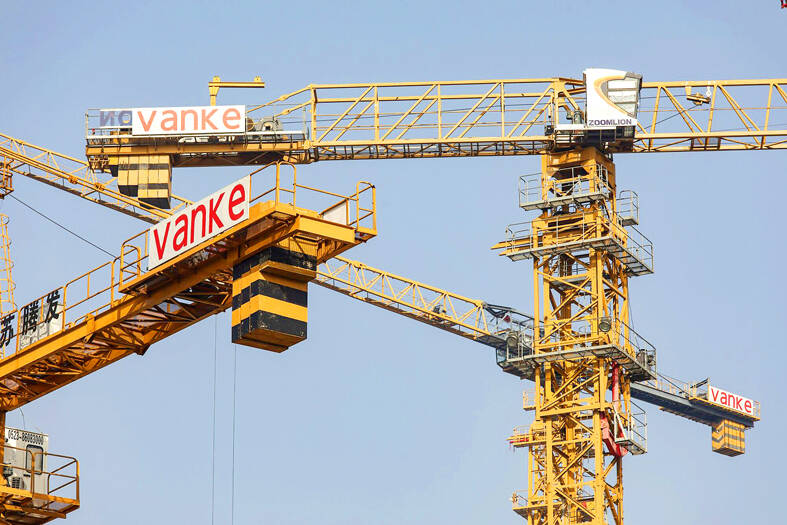China’s property debt crisis is showing new signs of trouble after entering its fourth year, with one of the country’s major state-backed developers under scrutiny by investors.
Some of China’s largest insurers are sounding an alarm over the debt risks of China Vanke Co (萬科), according to people familiar with the matter, as shares and bonds of the major developer hit record lows on repayment concerns.
At least two Beijing-based insurers that farm out annuity investments late last week told their external portfolio managers to closely monitor Vanke’s credit risks, the people said.

Photo: Bloomberg
One life insurer also told its pension managers to curb exposure, they said.
Vanke, China’s second-biggest developer by sales, has begun a new round of negotiations with several state insurers in the past few days to extend maturities of some private borrowings, the people said.
No deal has been reached.
In response to queries from Bloomberg, Vanke yesterday said that it has prepared funds to repay its 5.35 percent dollar bond due on Monday next week and that the payment is being arranged orderly.
The warnings about Vanke’s risks are particularly worrisome and threaten to elevate the sector’s debt woes to the next level because the company is seen as a bellwether for Beijing’s support for major developers with strong ties to the state.
The company is also one of China’s few remaining and surviving investment-grade builders, following a record wave of defaults that engulfed mostly private-sector builders, including former industry giants Country Garden Holdings Co (碧桂園) and China Evergrande Group (恆大集團).
The growing concerns about Vanke also come at an inconvenient time for authorities as the nation began its seven-day annual parliamentary sessions yesterday, with key policy topics from the housing crisis to local-government debt in focus.
Authorities pledged to refine real-estate policies to provide stronger support for the ailing sector, including treating developers equally regardless of their ownership.
“It is no surprise that Vanke is in trouble today,” Beijing Shengao Fund Management Co (深高基金管理) chief investment officer Li Kai (李凱) said. “Domestic real-estate sales have been so poor that it is difficult for companies to hang on, and the market has not seen strong visible support from local governments.”
Vanke had about 1.7 trillion yuan (US$236 billion) of assets and 1.3 trillion yuan of total liabilities as of the middle of last year, its interim report showed.
The builder on Friday last week said that it planned to raise about 1.16 billion yuan in an infrastructure REIT that would list in Shenzhen.

LIMITED IMPACT: Investor confidence was likely sustained by its relatively small exposure to the Chinese market, as only less advanced chips are made in Nanjing Taiwan Semiconductor Manufacturing Co (TSMC, 台積電) saw its stock price close steady yesterday in a sign that the loss of the validated end user (VEU) status for its Nanjing, China, fab should have a mild impact on the world’s biggest contract chipmaker financially and technologically. Media reports about the waiver loss sent TSMC down 1.29 percent during the early trading session yesterday, but the stock soon regained strength and ended at NT$1,160, unchanged from Tuesday. Investors’ confidence in TSMC was likely built on its relatively small exposure to the Chinese market, as Chinese customers contributed about 9 percent to TSMC’s revenue last

With this year’s Semicon Taiwan trade show set to kick off on Wednesday, market attention has turned to the mass production of advanced packaging technologies and capacity expansion in Taiwan and the US. With traditional scaling reaching physical limits, heterogeneous integration and packaging technologies have emerged as key solutions. Surging demand for artificial intelligence (AI), high-performance computing (HPC) and high-bandwidth memory (HBM) chips has put technologies such as chip-on-wafer-on-substrate (CoWoS), integrated fan-out (InFO), system on integrated chips (SoIC), 3D IC and fan-out panel-level packaging (FOPLP) at the center of semiconductor innovation, making them a major focus at this year’s trade show, according

DEBUT: The trade show is to feature 17 national pavilions, a new high for the event, including from Canada, Costa Rica, Lithuania, Sweden and Vietnam for the first time The Semicon Taiwan trade show, which opens on Wednesday, is expected to see a new high in the number of exhibitors and visitors from around the world, said its organizer, SEMI, which has described the annual event as the “Olympics of the semiconductor industry.” SEMI, which represents companies in the electronics manufacturing and design supply chain, and touts the annual exhibition as the most influential semiconductor trade show in the world, said more than 1,200 enterprises from 56 countries are to showcase their innovations across more than 4,100 booths, and that the event could attract 100,000 visitors. This year’s event features 17

Germany is to establish its first-ever national pavilion at Semicon Taiwan, which starts tomorrow in Taipei, as the country looks to raise its profile and deepen semiconductor ties with Taiwan as global chip demand accelerates. Martin Mayer, a semiconductor investment expert at Germany Trade & Invest (GTAI), Germany’s international economic promotion agency, said before leaving for Taiwan that the nation is a crucial partner in developing Germany’s semiconductor ecosystem. Germany’s debut at the international semiconductor exhibition in Taipei aims to “show presence” and signal its commitment to semiconductors, while building trust with Taiwanese companies, government and industry associations, he said. “The best outcome